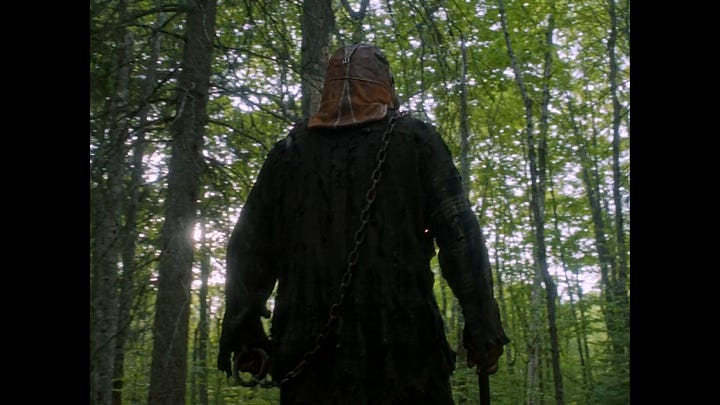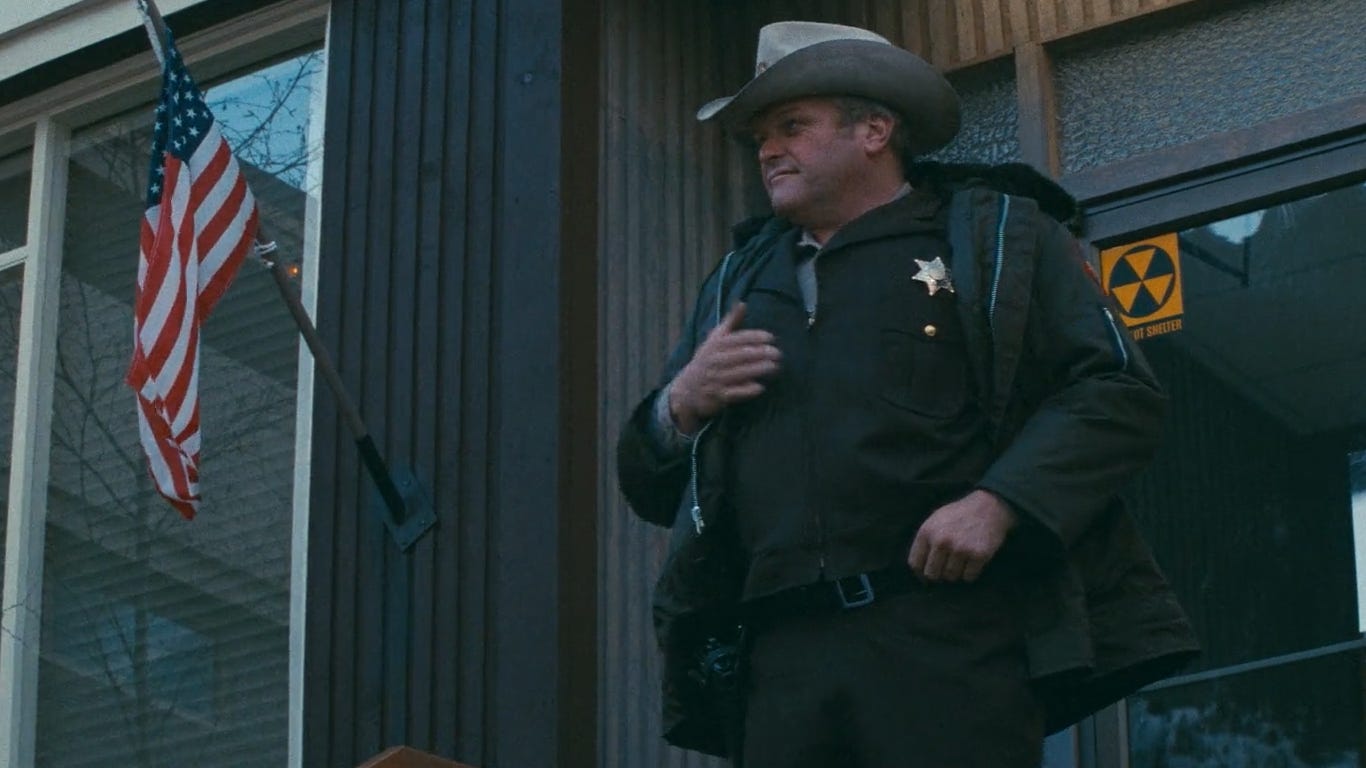Back to Back 42 - A Stroll in the Woods
Comparing films where that most dangerous of monsters lurks in the forest - an American
Rambo: First Blood (1982) - director Ted Kotcheff, co-writers Michael Kozoll, William Sackheim, and Sylvester Stallone
In a Violent Nature (2024) - writer/director Chris Nash
There's a stark dividing line between this inaugural movie, First Blood, and the subsequent Rambo films in the franchise, Rambo: First Blood II (1985), in which Rambo reverses the outcome of the Vietnam War, Rambo III (1988) in which Rambo wins the Cold War by occupying Afghanistan, Rambo (2008), something something Burma, and finally Rambo: Last Blood (2019) which demonstrates that Mexico is literally Hell, and should be occupied by real proper Americans for its own good.
All of these films, II through V, are absolute stinkers, progressively more and more reactionary and American-firstish as they sink into their own absurdity. These sorry efforts reflect nothing but disgrace on everyone involved, most especially Sylvester Stallone himself for becoming the grunting sweaty face of jingoistic futility and exceptionalism-as-hubristic-stupidity.
But the first one is far different. It drips with authentic feeling of an America that's lost its way, and its action is based on a burning sense of injustice, not on the puffed-up bombastic pseudopatriotic guff that motivates the nonsensical happenings in all the other Rambo films. That action is gritty and credible, Rambo himself a ghost assassin and not a superhero, and overall it comes across not as militaristic cartoon that ‘Rambo’ would come later to signify, but as a slasher horror where the slasher is the good guy and the police and their attached posse are the villains to be resisted.
Already in George A. Romero's Night of the Living Dead (1968) and Dawn of the Dead (1978) we get a solid sense that the key drivers of chaos and death in this apocalypse are the police and the deputized gangs that unleash indiscriminate violence across the country. That's nowhere more obvious than in the 1978 movie, where the SWAT team bring a massacre down on innocent civilians, black and hispanic, and cops Roger and Peter desert to look after themselves, taking care to fight off and deter other marauding cop gangs.
The second Dead film is only a few years before this first Rambo film, which made explicit the abandonment of Vienam veterans (mostly drafted into unwilling service) in favour of the privileged police officers, who volunteer for a life exercising their petty tyrannical power and have dodged both foreign service and contamination by American chemical warfare.
For First Blood is really the first ACAB film, in which the joy of seeing an entire police station of policemen taken down by one man, a man who starts the sequence naked and humiliated in the basement, before progressing steadily through an accumulating tribe of donut-fattened moustachioed slobs, constitutes a small revolution in itself.
Very few films before or since would be as frank about the systemic nature of police repression - not just the sheriff (Brian Dennehy), but each and every one of his slimeball deputies is party to the ritualized humiliation of Rambo at the beginning. Every single one of them measures his manhood in the faces he can can squash under his boot-heel. The film makes no bones about the true source of malaise in America, which is emblematized by a jackbooted thug with a star and a service-issued gun that he's itching to use.
Dennehy is special, but only because his charisma is of the type that makes us delight so in hating him. His thick-headed resolve to learn nothing and to continue to follow his losing strategy from start to finish mark him out as simply the most crazily determined of his self-harming fraternity. All his underlings, even down to the snotty little tyke who unwisely accompanies the deputies on the later manhunt, are out to prove their manhood by way of torture, degradation and blood on their blade.
Of course the drama as it finally plays out becomes the drama of Good Daddy versus Bad Daddy. Colonel Trautman (a very mediocre performance from Richard Crenna) is clearly positioned as the Good Daddy, despite the obvious question of his clearly instrumental use of Rambo in Vietnam not as warrior but as weapon, to be directed with no more thought to his ethical employment than a rocketlauncher. The Colonel, despite his protestations that he knows and sympathises with his men, doesn't even know that Rambo's comrade has died of cancer derived from exposure to Agent Orange. Some father.
Meanwhile Dennehy's Sheriff is unambiguously the evil father figure, a Daddy corrupted by his own ego and his joy in the exercise of his tyrannical authority. He claims to want nothing but peace for his rural community, but clearly delights in the chaos that he has sown, refusing to de-escalate at any point. With such men in power, suggests the film, America will never be at peace. And sure enough, Rambo himself would essentially become this Bad Daddy himself in subsequent films, wishing for intervention in Afghanistan and elsewhere, though never relinquishing his infantile affect as Big Dangerous Baby.
The scenes of Rambo being hunted in the forest are some of the greatest action scenes of the period, eschewing the grand explosions and bombastic set-pieces in favour of something more ghost-like and spooky, a shadowy figure that strikes in the liminal time of dusk and oncoming storm. There's something slasher-like about how mysterious he becomes when hunting that brings this film firmly into the horror genre for at least a sequence or two, which are coincidentally (or not) also the most beautifully filmed sequences in the film.
The Jerry Goldsmith score and the sound design also make this one of the most exciting films of the period to listen to, despite being from a year when the standard was set remarkably high (Blade Runner, Conan the Barbarian and The Thing all being tremendous pioneering works in music and sound from the same year, and Kubricks's The Shining set new markers in sound-for-horror just two years before). The era in film was moving through a real revolution in the integration of music and sound - foley and other effects - into the film as a whole, and this film has its place in all that too.
It's a curiosity, then that First Blood is actually far less important for having launched a franchise that would go on to demonstrate the worst of American cinema than for being a low-key masterwork in the growth of the thriller-as-slasher or the slasher-as-thriller crossover genre, something that is horror-adjacent but comes far short of being an actual horror film - and yet are we prepared to forget Rambo alone in a subterranean cavern having to fight off ravenous hordes of rats, and say this isn't a horror film?
— INTERMISSION —
Generally I avoid the slasher genre, and I still haven't seen a Halloween, Friday 13th or Nightmare on Elm St right through even once. It's not the gore as such, or the violence, it's the combination of cinematography and sound bites so obviously designed to make my pulse race. Its blatant manipulation of emotions I don't really have - becase I don't fear spookies, not even ones dressed like big gnarly men - just put me right off. I just refuse to allow myself to be used that way, and that refusal is the exact opposite of what you should do with a piece of Hollywood horror entertainment.
But In a Violent Nature... Oh the artistry! Such beautiful shots, some tracking, some still and framed. There's zero manipulation in that blatant Hollywood way, just brutal action set in absolutely gorgeous nature. It's that disjunct between stark beyond imagining horror and the beauty of the setting and montage that makes it a standout. The typical sequence of this film goes: tramp, tramp, tramp, tramp - closing slowly on a quarry - pause - tramp tramp tramp - closing slowly - arghh! the quarry is suddenly dead.




At all times full Jason rules are observed, so Johnny may lumber, but never run or even walk briskly. But he will always catch up with running quarry. If shot he will be stunned and fall down but not bleed, and of course never die. He prefers to have a head covering, the more old-school eerie the better, but doesn't really care if you see his face.
The action - such as it is, and if you added it all up it would be less than 10 minutes of the running time - tends to be filmed from two metres behind the protagonist, as he lumbers indifferently through the forest, though there are artful overhead shots and POV is switched enough times for the video-game perpective to never get old. The actual kill in any given encounter may or may not be shown. If shown, it may be shown briefly, or it may be explored in an excruciatingly slow sequence of deliberate cruelty. Nothing is predictable.
What inspires Johnny the killer? Ostensibly he wants his mother's locket back, it's a combination heirloom and talisman that can keep him magically placated and bound to a patch of safe ground. But Johnny is described as a small child, despite being a huge lumbering man, and he's clearly motivated by the same kind of experimentation and curiosity that a small child has for every piece of material substance that he or she encounters. How squishy is this substance? What happens if I poke it a few times? What happens if I poke it a lot of times? Can you cut this part off? Such is the human body for Johnny, a kind of plasticine or modelling clay made with blood and skin that is available to be manipulated in unimagined ways.
So the most creative kills have an impossible poetry to them, a fairytale sadism that couldn't be true in any real world of human anatomy or physiology, but this is a grace that is granted to Johnny because he wills it so. An audiacious creator, Johnny then immediately gets bored of his new creation and chucks it away indifferently.
Not for him the John Doe grandiosity of the killer in Se7en (1995) with his displays and allegories. This John Doe takes a simple pleasure in the act of mutilating and manipulating bodies, and once the act is complete, he has no wish to dwell on it, to preserve it for some bourgeois posterity to gawp at. Spontaneous desecration, creative laceration. Zen and the art of body arranging.
But the true star in the film is the forest itself, which at all times looks beautiful and serene, belying the title's "Violent Nature" which effectively belongs to the human monsters, not only the lumbering slasher. A long monologue attempts to foist off some of the evil onto nature itself, but nobody's buying that. One character passes through a panic and the forest comes alive in alien cries and disturbing sounds, but for the most part it chirps and rustles serenely. The forest gleams, radiates rich greens and sunset hues. At night it is bathed in moonlight glow and rich shadow. For Johnny, at least, it is a welcoming place.













That scene in IAVN about 41 minutes in is probably one of the most gruesome creative things Ive ever seen in a film. The world here is gorgeous, fellow North Ontario boy Chris Nash, filmed it in the Canadian Shield near where he grew up. This felt nostalgic to me.
You're spot on with the First Blood>Rambo franchise take. For me the most poignant scene was when Denehy dropped Rambo off and our unwitting hero about-faced right after. A scene of true rebellion.